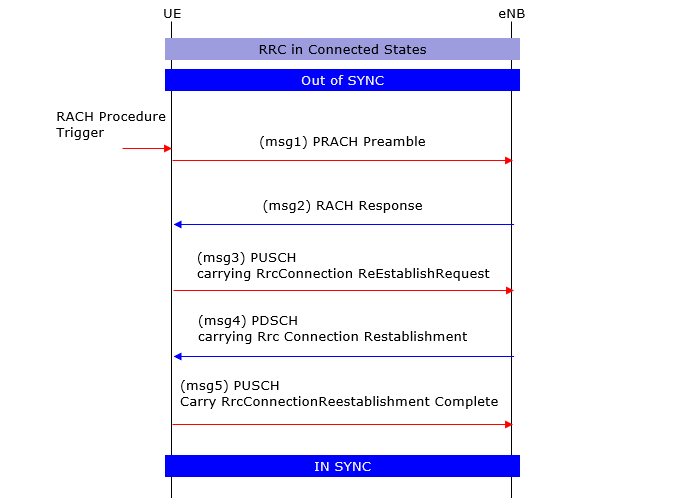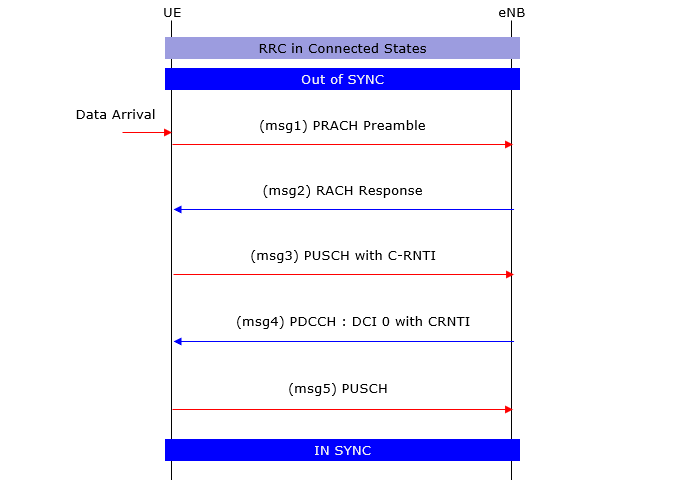|
Radio Link Failure (RLF)
Radio Link Failure (RLF) in LTE occurs when the quality of the connection between the User Equipment (UE) and the network degrades beyond recovery. This node will describe how the UE detects and manages physical layer problems in RRC_CONNECTED and the subsequent RLF.
When UE Report RLF ?
Then the next question would be "How UE or eNodeB can detect this kind of Radio Link Failure ?". Unfortunately we don't have any clear answer to this question either. So detailed detection implementation is up to UE maker and eNodeB maker, but we can think of several guidelines.
UE may assume that Radio Link is broken in the following setuation.
- The measured RSRP is too low (under a certain limit)
- It failed to decode PDCCH due to power signal quality (e.g, low RSRP, RSRQ)
- It failed to decode PDSCH due to power signal quality (e.g, low RSRP, RSRQ)
However, detailed mechanism to RLF is upto the chipset implementation. So the individual RLF detection mechanism may vary chipset-to-chipset.
eNodeB may assume that that Radio Link is broken in the following setuation.
- SRS Power (SINR) from UE is much lower than what eNB configured for the UE
- eNodeB couldn't detect (see) any NACK nor ACK from UE for PDSCH.
Does UE or eNodeB declare "Radio link Failure" whenever it sees the problem described above, even for only one subframe ?
No, it is not. In most case, this kind of problem should happen for a certain period of time consecutively and a couple of timers and parameters are involved in the criteria setup. (See T311, n310)
Conditions for Declaring RLF
The UE declares RLF under the following circumstances (as per 5.3.11.3 of 3GPP TS 36.331):
- T310 Expiry:
- After N310 consecutive "out-of-sync" indications and the subsequent expiry of T310, the UE declares RLF.
- T312 or T318 Expiry:
- If T312 (configured for SCG failure recovery) or T318 (DAPS handover recovery) expires.
- Random Access Problem:
- The UE experiences a random access problem while no higher-layer timers (e.g., T300, T301, T304, or T311) are running.
- Maximum Retransmissions Reached:
- The MAC or RLC layer indicates that the maximum number of retransmissions for an SRB or DRB has been reached.
Reporting Conditions
The UE only reports RLF when:
- Re-establishment Succeeds:
- If the UE successfully re-establishes its connection, the RLF report is sent to the network.
- The UE Returns to the Same Network:
- The RLF report is sent if the UE connects to the same PLMN or its equivalent PLMNs after the failure.
- If the UE cannot re-establish a connection:
- The RLF report is not sent, as there is no signaling interface to communicate with the network.
Example Reporting Scenarios
- Normal Operation: The UE experiences poor signal quality, declares RLF, and re-establishes the connection. It sends the RLF report to inform the network about the issue.
- Handover Failure: The UE fails to connect to the target cell during a handover, declares RLF, and provides the report during re-establishment.
- Dual Connectivity: If SCG RLF occurs, the UE sends an SCG-specific failure report to assist in improving the network configuration.
What UE tries to do when RLF Happens ?
Then the next question would be "What UE does when it detects Radio Link Failure ?" or "What eNodeB does when it detects Radio Link Failure ?".
When Radio Link Failure (RLF) occurs, the User Equipment (UE) initiates specific recovery and fallback actions to restore or maintain service continuity. The actions depend on the scenario (e.g., idle mode, connected mode, handover, or multi-connectivity)
Connection Re-Establishment Attempt
The most typical procedure is to go through RRC Connection Restablishement procedure. The UE tries to reconnect to the network by initiating the RRC Connection Re-Establishment Procedure:
- Triggering Re-Establishment:
- The UE sends an RRCConnectionReestablishmentRequest message to the network.
- This message is sent to:
- The last serving cell if it is still accessible.
- A neighboring cell that supports the same PLMN (if the serving cell is not accessible).
- Wait for Response:
- If the target cell accepts the request, the network sends an RRCConnectionReestablishment message.
- The UE applies the reconfiguration and resumes the connection.
- Successful Re-Establishment:
- The UE resumes its previous radio bearers.
- It reports the RLF to the network using the RRCConnectionReestablishmentComplete message.
< Attemp to recover Radio Link while Out of SYNC (Radio Link Failure) - RRC Connection ReEstablishment >

< When UL Data arrives from higher layer while Out of SYNC (Radio Link Failure) >

Initiating Connection Establishment (if Re-Establishment Fails)
If re-establishment fails (e.g., the target cell rejects the request or the UE cannot find a suitable cell), the UE:
- Moves to the RRC_IDLE state.
- Initiates a full RRC Connection Establishment Procedure with a new cell:
- Performs cell selection or reselection.
- Sends an RRCConnectionRequest to the selected cell.
Handling in Handover Scenarios
In the case of a handover, the UE:
- Reverts to the source cell configuration if the target cell cannot be accessed (e.g., T304 expiry).
- Initiates connection re-establishment with the source cell.
Handling in Multi-Connectivity (e.g., EN-DC, NE-DC)
If dual connectivity is configured:
- SCG Failure (Secondary Cell Group):
- If RLF is detected on the SCG (e.g., T313 expiry):
- The UE reports SCG failure using the SCGFailureInformation message.
- It continues communication over the MCG (Master Cell Group).
- MCG Failure:
- If RLF is detected on the MCG, the UE initiates re-establishment.
Information Retention and Reporting
If RLF occurs:
- The UE stores the following information in VarRLF-Report:
- Global cell ID of the failed cell.
- Measurements (RSRP, RSRQ) of the failed cell and neighboring cells.
- Timing information about the failure.
- This information is retained for 48 hours or until:
- The UE powers off.
- The UE detaches from the network.
- The UE switches to another RAT (for NB-IoT).
Actions Upon Reconnection
When the UE successfully reconnects after RLF:
- It resumes any ongoing data or signaling sessions.
- It reports the RLF to the network (if the connection is re-established within the same PLMN).
- It may receive updated configurations to improve link stability
Fallback Scenarios
If the UE fails to re-establish the connection:
- It falls back to RRC_IDLE state.
- It may perform cell reselection to find a new suitable cell.
- For specific services (e.g., emergency calls), the UE may attempt access on a different RAT (e.g., GERAN, UTRAN).
|
|

